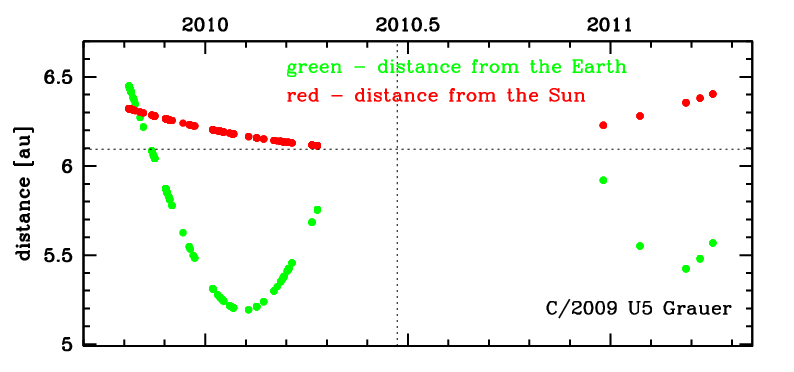C/2009 U5 Grauer
more info
C/2009 U5 was discovered by Albert D. Grauer on 23 October 2009 on images taken with the Mt Lemmon 1.5-m reflector [IAUC 9088, 2009 October 25].
This comet made its closest approach to the Earth on 3 February 2010 (5.191 au), 4.7 months before perihelion passage.
Solution given here is based on data spanning over 1.4 yr in a narrow range of heliocentric distances: 6.32 au – 6.094 au (perihelion) – 6.41 au.
This Oort spike comet suffers rather small planetary perturbations during its passage through the planetary system that lead to escape of the comet from the solar system on hyperbolic orbit (see future barycentric orbit).
See also Królikowska 2014 and Królikowska and Dybczyński 2017.
This comet made its closest approach to the Earth on 3 February 2010 (5.191 au), 4.7 months before perihelion passage.
Solution given here is based on data spanning over 1.4 yr in a narrow range of heliocentric distances: 6.32 au – 6.094 au (perihelion) – 6.41 au.
This Oort spike comet suffers rather small planetary perturbations during its passage through the planetary system that lead to escape of the comet from the solar system on hyperbolic orbit (see future barycentric orbit).
See also Królikowska 2014 and Królikowska and Dybczyński 2017.
| solution description | ||
|---|---|---|
| number of observations | 187 | |
| data interval | 2009 10 23 – 2011 04 02 | |
| data type | significantly more measurements before perihelion (PRE+) | |
| data arc selection | entire data set (STD) | |
| range of heliocentric distances | 6.32 au – 6.09 au (perihelion) – 6.41 au | |
| detectability of NG effects in the comet's motion | NG effects not determinable | |
| type of model of motion | GR - gravitational orbit | |
| data weighting | YES | |
| number of residuals | 359 | |
| RMS [arcseconds] | 0.52 | |
| orbit quality class | 1a | |
| next orbit statistics, both Galactic and stellar perturbations were taken into account | ||
|---|---|---|
| no. of returning VCs in the swarm | 0 | |
| no. of escaping VCs in the swarm | 5001 | |
| no. of hyperbolas among escaping VCs in the swarm | 5001 | * |
| next reciprocal semi-major axis [10-6 au-1] | -229.24 – -226.85 – -224.49 | |
| next perihelion distance [au] | 0.175 – 0.185 – 0.196 | |
| synchronous stop epoch [Myr] | 1.12 | S |
| percentage of VCs with qnext < 10 | 100 | |
| next_g orbit statistics, here only the Galactic tide has been included | ||
|---|---|---|
| no. of returning VCs in the swarm | 0 | |
| no. of escaping VCs in the swarm | 5001 | |
| no. of hyperbolas among escaping VCs in the swarm | 5001 | * |
| next reciprocal semi-major axis [10-6 au-1] | -229.17 – -226.78 – -224.43 | |
| next perihelion distance [au] | 0.143 – 0.155 – 0.167 | |
| synchronous stop epoch [Myr] | 1.12 | S |
| percentage of VCs with qnext < 10 | 100 | |
